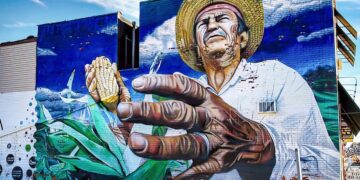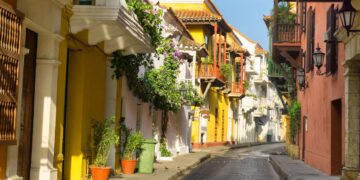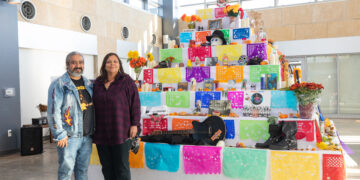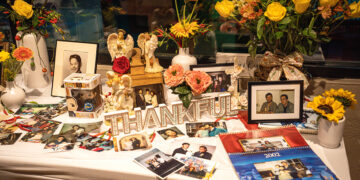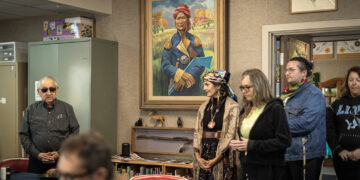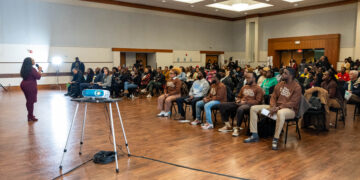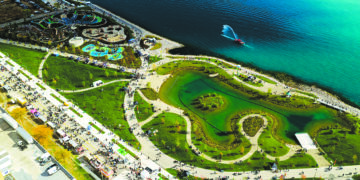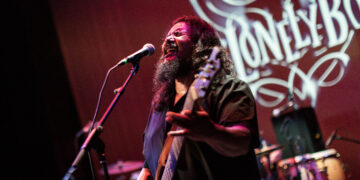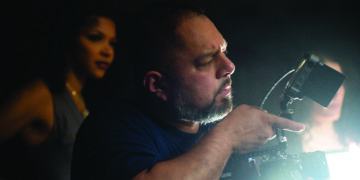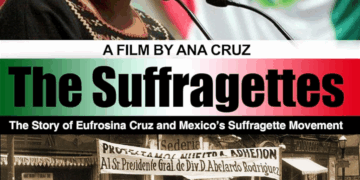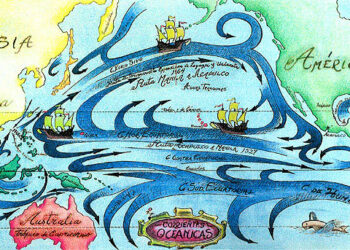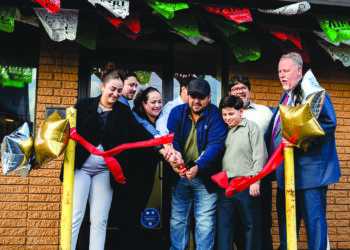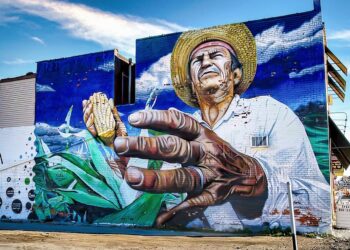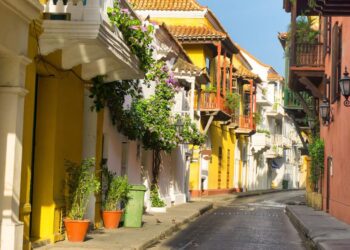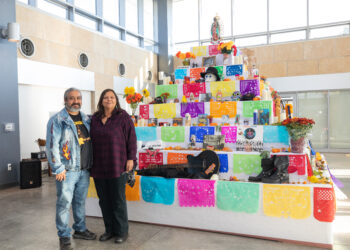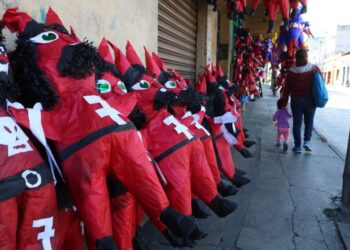The Burning of the Devil is one of Guatemala’s most important national festivities and is celebrated on December 7th every year. While its exact origins are unknown, it is believed to date back to the colonial period. The Burning of the Devil originated as a prelude to the celebration of the birth of the Immaculate Virgin Mary. This is of great importance to the Catholic Church, as she was born without the original sin inherited from Eve. The celebrations for the Virgin of the Immaculate Conception take place on December 8th, and were formerly celebrated with the lighting of bonfires and lanterns throughout the city, in what was the old Hermitage, now Guatemala City.
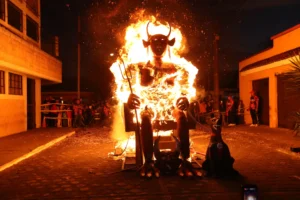
Some authors also say that the festival originated as part of the preparations for Christmas, when families cleaned and prepared their homes, removing everything that was no longer useful as a symbol of the devil’s defeat with the birth of Jesus Christ. The festival requires cleaning the homes; that is, tidying the house and corners, throwing away trash, old things, things that are no longer useful and that have accumulated during the year. All of this is done to achieve purification, since it is said that the devil hides among these things, and for this reason, they must not only be removed but also burned, to make room for good, such as the birth and arrival of the baby Jesus as the epitome of benevolence.
The Burning of the Devil not only burns the devil, but bonfires are lit throughout the city where piñatas with the effigy of the devil, molded from wire and covered in papier-mâché or red tissue paper, are burned. One of the most important parts of the Burning of the Devil celebration is the reading of the Devil’s Testament, in which everything he did is recounted. The Burning of the Devil takes place after six in the evening with the procession of the Virgin of the Immaculate Conception. It is said that the tradition of making piñatas with images of the devil began around 1960, since prior to this, bonfires were only used to celebrate the Virgin. However, with religious prohibitions, the tradition gradually transformed into what is now the Burning of the Devil as a symbol of evil.

The Burning of the Devil festival begins at noon with the burning of fireworks to summon the community. Later, at 3:00 pm, the arrival of the devil is usually celebrated, and at 5:45 pm, the reading of the Devil’s Testament takes place, in which he mentions the parts of his body and why they will be burned. At six o’clock sharp, the Burning of the Devil begins, followed by a celebration with live music, as a celebratory concert is usually held. The main celebration takes place in the Barrio de la Concepción, in Antigua, the capital of Guatemala.
Although the tradition belongs to Guatemala, this practice can be combined with other annual practices, since it goes without saying that every year many people try to take stock in December of everything they achieved and left behind during the year that is ending. In this way, we can prepare ourselves in these days for 2026 by letting go of everything that was no longer part of our lives in these months, to start a new year with more space not only in our homes, but also in our lives and within ourselves.
The Burning of the Devil festival is not the only symbol of burning away evil, malevolence, and the diabolical within the Spanish-speaking societies of the continent. In countries like Mexico, the parallel is carried out on December 31st with the Burning of the Old Year, an old man who will give way to the birth of the New Year.
La Quema del Diablo es una de las festividades guatemaltecas más importantes a nivel nacional y se celebra el 7 de diciembre de cada año aunque no se sabe exactamente el año en que se inició, pero se sabe que viene del periodo colonial.
La Quema del Diablo se dio como preámbulo a la celebración del nacimiento de la Virgen Inmaculada María, pues recordemos que esto para la iglesia católica tiene gran importancia, pues ella nació sin el pecado original heredado por Eva. Los festejos de la Virgen de la Inmaculada Concepción son el día 8 de diciembre que anteriormente se festejaba con el encendimiento de luminarias y fogatas por toda la ciudad de lo que era la antigua Ermita, actual ciudad Guatemala.

Algunos autores dicen también, que la festividad tuvo origen como parte de los preparativos para las fechas navideñas cuando las familias limpiaban y preparaban sus casas sacando todo aquello que no sirviera como símbolo del vencimiento del diablo con el nacimiento de Jesucristo
La festividad requiere la limpieza de los hogares, es decir: aseo del hogar y rincones, tira de basura, cosas viejas, cosas que no sirven y que se han acumulado durante el año, todo esto en aras de llevar a la purificación, pues se dice que el diablo se esconde entre estas cosas y por esa razón no sólo se deben sacar, sino también quemar, para así dar espacio para lo bueno, como es el nacimiento y llegada del niño Jesús como máxima de lo benevolente.
La Quema del Diablo no sólo quema al diablo, sino que las fogatas se encienden por toda la ciudad donde se quemará piñatas con la efigie-figura del diablo moldeadas con alambre y cubiertas de papel maché o papel de china rojo.
Una de las partes más importantes de la celebración de la Quema del Diablo es la lectura del Testamento del Diablo, en el cual se da lectura de todo lo que hizo.,
La Quema del Diablo se hace después de las seis de la tarde con la procesión de la Virgen de la Inmaculada Concepción. Se dice que fue hasta mediados del siglo XIX, por ahí de 1960 cuando la realización de las piñatas con imágenes del diablo se dio inicio, puesto que previo a esto, las fogatas sólo eran para festejar a la virgen, no obstante, con las prohibiciones religiosas la tradición fue transmutándose hasta lo que es la Quema del Diablo como símbolo de lo malo.
La fiesta de la Quema del Diablo se da inicio desde medio día con la quema de pólvoras para el llamamiento de la comunidad. Posteriormente, a las 3:00 pm sueles darse la llegada del diablo y a las 5:45 pm se lleva a cabo la lectura del Testamento del Diablo, donde éste menciona las partes de su cuerpo y porqué las van a quemar. A las seis en punto se inicia con la Quema del Diablo para posteriormente dar pie a la celebración con música en vivo, pues, comúnmente se lleva a cabo un concierto de festejo. La celebración principal se lleva a cabo en el Barrio de la Concepción, en Antigua, capital de Guatemala.

Aunque la tradición pertenece a Guatemala, esta práctica puede congeniarse con otras prácticas anuales, pues sobra decir que año con año muchas personas procuran en el mes de diciembre hacer un conteo de todo lo que se logró y lo que se dejó atrás durante el año que termina, así, podemos prepararnos en estos días para el 2026 sacando todo aquello que ya no fue parte de nuestras vidas en estos meses, para empezar un año nuevo con más espacio no sólo en nuestros hogares, sino también en nuestras vidas y nuestro interior.
La fiesta de la Quema del Diablo no es el único símbolo de quema de lo malo, maligno y diabólico dentro de las sociedades hispanoparlantes del continente.
En países como México, se lleva a cabo el paralelismo el 31 de diciembre con la Quema del año viejo, un señor anciano que dará pie al nacimiento del Año nuevo.



